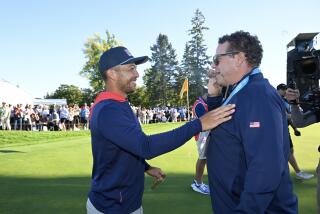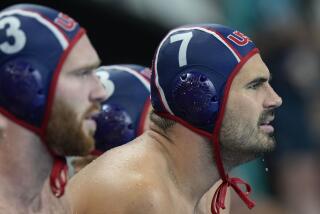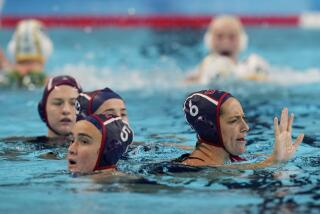The Secrets of Televising the America’s Cup
SAN DIEGO — Sights and sounds from the race toward the America’s Cup:
United States’ Stars & Stripes crewman Wally Henry yells from below deck: “It’s cracking ... a lot of water!”
Trimmer Bill Trenkle straightens up and eases the headsail as Ralf Steitz darts in and out of view. “Get (the tender) Betsy ready with the pump,” Steitz says.
“I gotta go up (the mast) to take the main down,” bowman Greg Prussia tells his crew mates. “If we sink, make sure you’re there (to help him back down).”
That’s how it was the day Dennis Conner’s boat almost lost its keel and sank--on live TV. On-board cameras and microphones caught it all.
And that’s why, when friends ask, “What’s the best way to see the America’s Cup?,” I tell them to come to San Diego, tour the syndicate gift shops, watch the boats leave, enjoy a fresh fish lunch-- then go back to their room, kick off their deck shoes and catch the action on ESPN. (The cable sports network’s coverage of the final Cup Match starts Saturday.) And if you don’t care about the frills, stay at home for the duration.
Trust me. It’s better on TV, on shore.
Most days, an afternoon of watching the 80-foot International America’s Cup Class boats drift along lazily in San Diego’s normal 5 knots of precious zephyr could be as well spent waiting for paint to dry. But up close, the activity on board is constant. With stable on-board cameras and microphones, you see more, hear more in your television room than some of the sailors at the other end of the boat.
Producer Jed Drake is doing his fourth Cup for ESPN. Like Television New Zealand, which has been disrupting each workaday morning Down Under with its coverage, ESPN receives its video and audio feeds from ACTV, the television arm of the event.
ACTV producer-director Geoff Mason controls rotating zoom cameras on the race boats from shore, and there are other cameras on chase boats and helicopters. The cameras are everywhere but under water.
Drake and director Doug Holmes can select images from 46 small monitors and three large screens in their cramped mobile-home control room at the temporary International Broadcast Center lot on San Diego’s commercial waterfront.
Their choices include SailTrack, a feature developed by Trimble Navigation and Silicon Graphics based on Global Positioning System (also known as GPS) technology. Using tracking lines and other graphics, SailTrack offers a clear perspective to the two boats’ positions relative to each other and the marks of the 3-mile-long race course. Even when the boats are far apart on different tacks, the viewers know which one’s in front. The information is updated each half-second and accurate to 8 inches. A new feature, the “line of equality,” adjusts constantly for wind shifts favoring one boat or the other.
ESPN also has a gimmick to show realistic computer models of the boats under sail, with details down to the sponsors’ logos. Not only that, technician John Wilson says, as he demonstrates, but, “I can change to any sails they have.”
Sometimes the action in the control room is more frenetic than it is on the water. Drake and his crew of a dozen must juggle commercial breaks, expert analysis and pre-taped features around live action and not miss any mark roundings or boat crossings. Through his headset, Drake, like a coach, cajoles, chastises and praises. Sometimes he takes a breath and pats Holmes on the back.
“OK, guys,” Drake says one day as Conner was beating Young America, the boat from Maine, as Team New Zealand routed oneAustralia, “the action is on the defenders’ course ... nothing happening with the challengers. Let’s work the devil out of Dennis.”
By agreement, three members of each crew are supposed to wear mikes. “Some of them don’t like it,” says Drake’s sound man, Jonathan Freed. But they do it.
All of this supports the ESPN commentators: anchor Jim Kelly and sailing experts Gary Jobson and Peter Isler. Jobson or Isler alternate day to day on the water. The other works ashore analyzing from monitors with Kelly, or Kelly’s alternate, Adrian Karsten.
They watch the drama evolve as you do. Here’s Mighty Mary bowman Susie Nairn with a bandage under her left eye, grinning as the women take the lead from Stars & Stripes.
And there’s the horror of New Zealand’s TAG Heuer crewman Steve Cotton chasing his severed fingers across a pitching deck.
Stay on shore. You won’t miss a thing. Trust me.
ESPN’s coverage of the “America’s Cup” final races begins Saturday at 1 p.m.
More to Read
Sign up for The Wild
We’ll help you find the best places to hike, bike and run, as well as the perfect silent spots for meditation and yoga.
You may occasionally receive promotional content from the Los Angeles Times.






